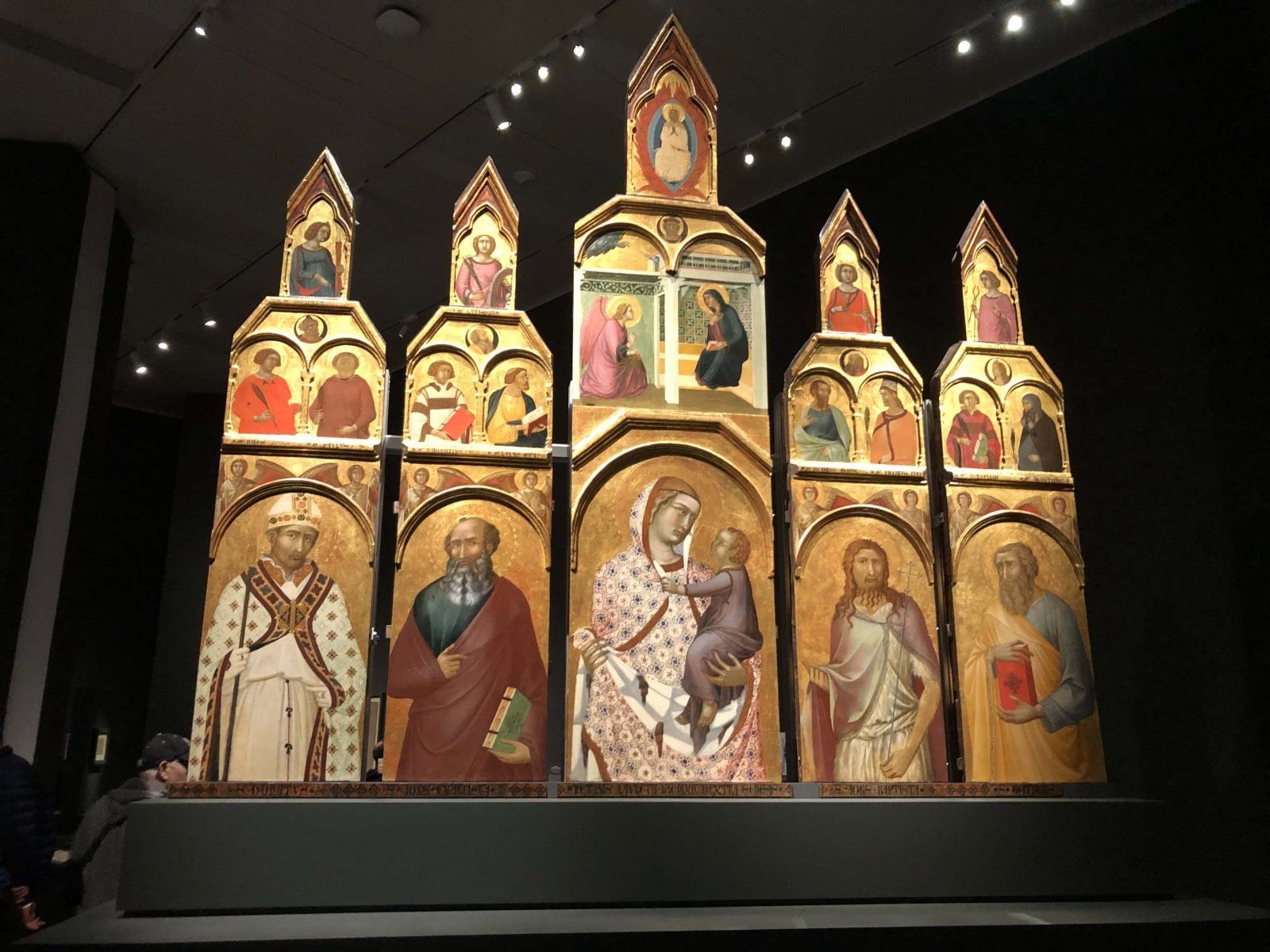Cover image: Pietro Lorenzetti, The Pieve Altarpiece, c. 1320. Chiesa di Santa Maria della Pieve, Arezzo, Italy. Photo by A Scholarly Skater.
Siena: The Rise of Painting, 1300-1350 is an exhibition of early Italian Renaissance religious art at the Metropolitan Museum of Art. Featuring paintings made in Siena, Italy in the first half of the 14th century CE alongside contemporaneous European objects, the show focuses on the innovations that Sienese artists made in this era. In particular, four Sienese greats – Duccio, Simone Martini, and Pietro and Ambrogio Lorenzetti – play starring roles, and the show’s primary attraction is in bringing together masterworks that haven’t been in the same place for centuries.
Gold-ground paintings

The major highlights of this show are its gold-ground paintings. some of which are famous enough to appear in art history survey courses and textbooks. A phenomenon of the late Middle Ages and early Renaissance, particularly in Italy, gold-ground paintings depict Christian religious subjects in tempera paint on wooden panels with backgrounds of gold leaf. Since both the wood and the gold can be elaborately worked and textured, the overall effect is architectural, glittering, and even otherworldly. With the increased use of oil paint, canvas supports, and naturalistic painted settings with linear perspective, gold-ground paintings were supplanted later in the Renaissance. For a long time, they were derided as being overly decorative and non-naturalistic, but they’ve since developed a substantial and devoted following.
While I’m usually fairly neutral about gold-ground paintings – I’m happy to look at them but don’t necessarily seek them out – I really enjoyed them here and think I maybe have gained a new appreciation for them. In particular, I was excited to see a set of panels from the predella (lower section) of Duccio’s famous Maesta altarpiece. Since the individual panels are now in museums throughout the United States and Europe, this is the first time they have been reassembled in centuries. (The famous centerpiece showing the Virgin and Christ Child Enthroned is not included.) I also enjoyed Pietro Lorenzetti’s Pieve Altarpiece and panels from Simone Martini’s Palazzo Pubblico Altarpiece. The former is particularly cool because it’s still intact, and the display lets you see its structural supports as well as its imagery. Sculpture plays a smaller role in the show, but the quartet of dramatically-displayed sculptures by Gano di Fazio stood out nonetheless as some of my favorite works.
The exhibition galleries are surprisingly modern looking, featuring dark grey walls, simple displays, and a series of stark pillars as set pieces. This is not what I would have expected for artworks originally made for elaborate Renaissance churches, but it actually shows off these brightly colored and gilded paintings magnificently. However, some of the smaller objects were a little difficult to see in detail because of the lighting glare against their display cases.
Comparisons and Connections

The exhibition opens with a gallery that encourages a direct comparison of the Duccio’s Madonna and Child (above) from the Met’s own collection with a Byzantine icon and French ivory statue of the same subject. The point is to demonstrate how Duccio both used existing conventions and expanded upon them. This idea of the relationship between Sienese painting and broader traditions is one that recurs throughout the show. For example, we see Sienese art juxtaposed with carved ivories that may have inspired it and illuminated manuscripts it in turn may have influenced. The relatively limited repertoire of Christian scenes and figures within most of these artworks makes for easy comparisons. I particularly enjoyed a section about Siena’s luxury textile trade that pointed out where Sienese artists depicted foreign fabrics within their paintings.
Opinion

Overall, the exhibition is easy to appreciate. The major concepts are not complex or groundbreaking, and the texts that explain them are fairly short and easy to skim. This is not a show where you have to do an excessive amount of reading to understand what’s going on, but there’s still plenty you can learn from it. In my opinion, there was also just the right amount to see – enough to give good variety and a feel for the subject, but not so much that it got overwhelming. Despite not being particularly small, these paintings require some real attention, and I felt that I could give that to each piece without getting burnt out by the quantity of them.
I did get the impression that the curators expected a relatively knowledgeable audience already familiar with this art, but I don’t think there’s anything to stop an interested newcomer from understanding and enjoying the show. And I was pleasantly surprised by how well attended this show was during my Sunday visit. I would not think of early Renaissance religious art as a popular topic, yet there were plenty of people in the galleries engaging with the art – everyone from older couples to tour groups to young nuns. It wasn’t full enough for the museum to use timed entry, but it was definitely crowded, and I had to wait my turn to see some of the works.
Details

I really enjoyed this Siena: The Rise of Painting, 1300-1350 and recommend seeing it if you like shiny, beautiful things – even if you’re not a big enthusiast for gold-ground paintings. The show runs at the Metropolitan Museum of Art in New York City through January 26, 2025. (I have a feeling it could be very crowded over Christmas break!) Click here for more information. If you scroll to the bottom of that page, you can also watch an informative, 18-minute video about the exhibition’s main ideas and highlights. I enjoyed it after my visit to learn more about what I had already seen, but it could just as easily be a great introduction or a taster if you can’t see the show in person.


